New Data Center, Professional v1.0
Question 1
You are configuring an IP Fabric in your data center and you are trying to load-balance traffic across multiple equal-cost BGP routes. You have enabled multipath, but the traffic is not being load-balanced.
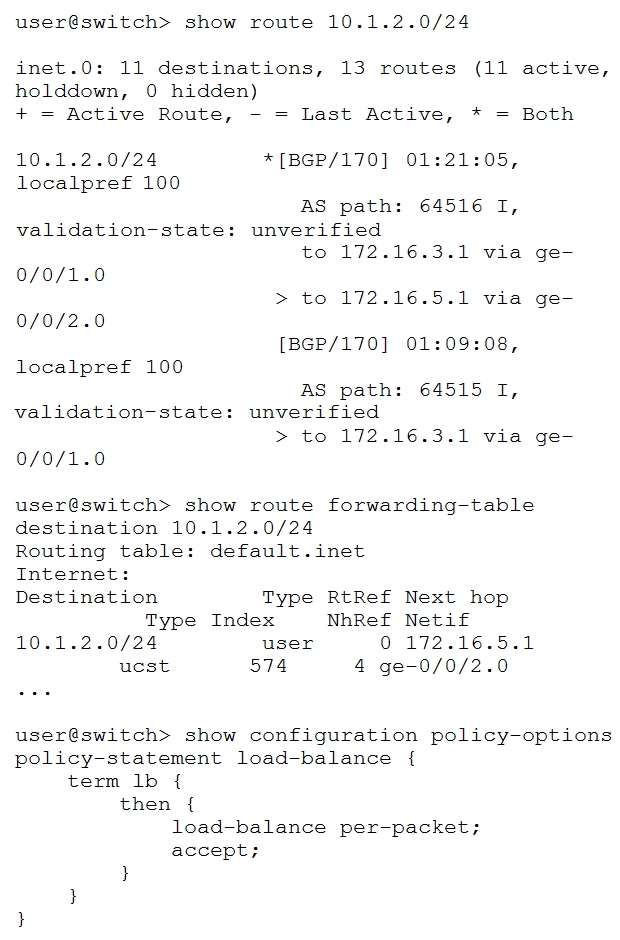
Referring to the exhibit, what will solve this problem?
- A. You should apply the load-balance policy as an import policy to the forwarding table.
- B. You should apply the load-balance policy as an import policy for the BGP neighbor.
- C. You should apply the load-balance policy as an export policy to the forwarding table.
- D. You should apply the load-balance policy as an export policy to the BGP neighbor.
Answer : C
Question 2
When using EBGP as the underlay protocol for your IP fabric architecture, which two statements are true? (Choose two.)
- A. Spine nodes only peer to leaf nodes.
- B. Leaf nodes peer to both spine and leaf nodes.
- C. Leaf nodes only peer to spine nodes.
- D. Spine nodes peer to both leaf and spine nodes.
Answer : AC
Question 3
What are three advantages of using MPLS for data center interconnects? (Choose three.)
- A. dedicated MPLS backbones for Layer 2 and Layer 3 DCIs
- B. any-to-any connectivity
- C. traffic engineering
- D. dedicated connections between customer sites
- E. sub 50 ms failover times
Answer : ACE
Question 4
You have configured a new MC-LAG connection to a host. After committing the configuration, the MC-LAG link is not functioning properly.
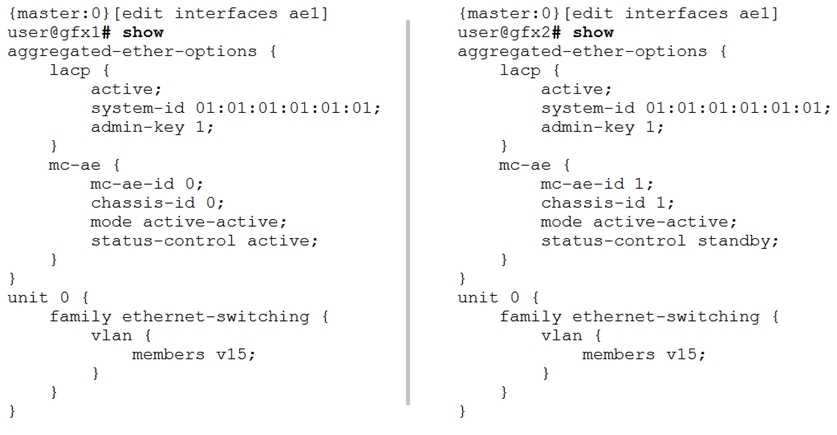
Referring to the exhibit, how would you solve this problem?
- A. Change the chassis-id on qfx1 to 1.
- B. Configure a system-id on qfx1 that is different from the system-id on qfx2.
- C. Configure the status-control on qfx2 to active.
- D. Change the mc-ae-id on qfx1 to 1.
Answer : D
Question 5
Which two combinations are supported when configuring a Virtual Chassis Fabric? (Choose two.)
- A. two spine nodes and 28 leaf nodes
- B. four spine nodes and 20 leaf nodes
- C. four spine nodes with 16 leaf nodes
- D. two spine nodes and 16 leaf nodes
Answer : CD
Question 6
The MC-LAG group shown in the exhibit is providing high availability services for the directly connected servers. The backup liveness detection is applied to the
ICL-PL link, however, when one of the members rebooted, there was traffic loss for a few seconds.
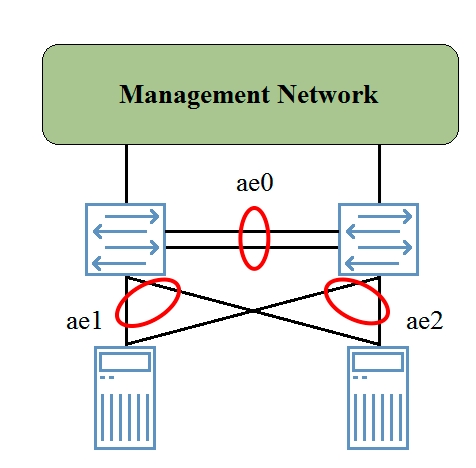
In this scenario, where should you apply the backup liveness detection?
- A. on the ae1 interface
- B. on the ae2 interface
- C. on the management interfaces
- D. on the ae0 interface
Answer : C
Question 7
Which two statements define the use of route targets and route distinguishers in an EVPN? (Choose two.)
- A. Route targets ensure that routes from different clients remain unique within the data center domain.
- B. Route targets identify the VRF into which the route should be placed.
- C. Route distinguishers ensure that routes from different clients remain unique within the data center domain.
- D. Route distinguishers identify the VRF into which the route should be placed.
Answer : BC
Question 8
Which two statements describe an IP fabric? (Choose two.)
- A. Open standards allow for vendor interoperability.
- B. Each leaf should have a connection to each spine.
- C. xSTP protocols should be used to prevent loops.
- D. Traffic should always follow a single path.
Answer : BC
Question 9
What is the purpose of the command shown in the exhibit?

- A. to stop the transmission of transit multicast traffic when there are no interested receivers attached to a remote VTEP.
- B. to disallow IGMP requests for the group 239.0.0.1 from hosts attached to the local VTEP.
- C. to disable the multicast group 239.0.0.1 across the entire VXLAN.
- D. to stop the reception of transit multicast traffic when there are no interested receivers attached to the local VTEP.
Answer : A
Question 10
You have deployed two data centers that require a Layer 2 stretch between host1 and host2.
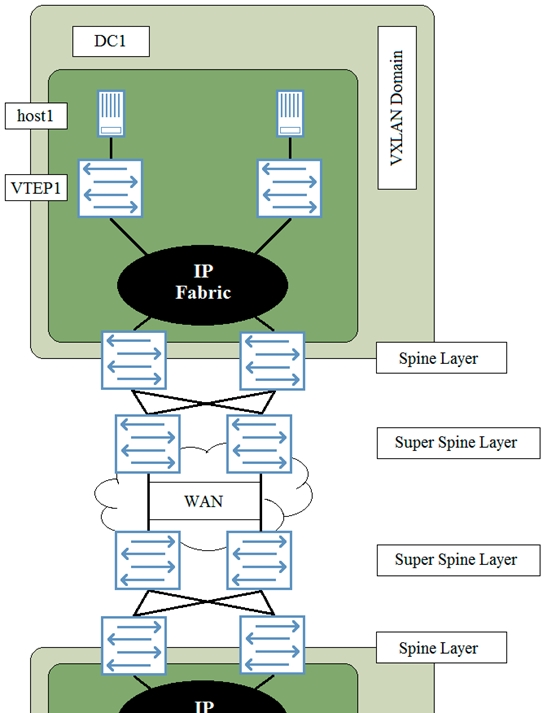
Referring to the exhibit, what does a Layer 2 stretch require?
- A. a VXLAN tunnel originating on the Super Spine Layer in DC1 to the Super Spine Layer in DC2.
- B. a VXLAN tunnel originating on VTEP1 to VTEP2.
- C. a VXLAN tunnel originating on the Spine Layer in DC1 to the Spine Layer in DC2.
- D. a VPLS WAN connection between data centers.
Answer : B
Question 11
Referring to the exhibit, each node in the IP fabric is peering to its directly attached neighbor using EBGP. Each node is peering using physical interface IP addresses. Leaf 2 and Leaf 3 are advertising the 10.1.1/24 network into EBGP. Spine 2 must be configured so that it can load-share traffic destined to the 10
1.1/24 network over both next-hop A and next-hop B.
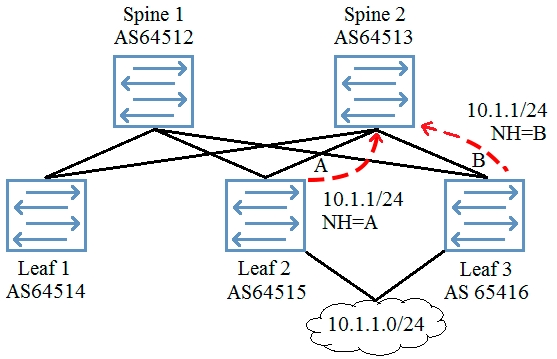
Which two actions must be performed to accomplish this task? (Choose two.)
- A. Use a load-balancing policy applied to the forwarding table.
- B. Use multipath multiple-AS.
- C. Use advertise-inactive.
- D. Use multihop.
Answer : AB
Question 12
Which two statements describe EVPN-based VXLAN implementations? (Choose two.)
- A. The movement of a virtual host requires a manual reconfiguration of the VTEP.
- B. The movement of a virtual host results in the dynamic remapping of the VTEP.
- C. MAC addresses are learned using multicast flooding.
- D. MAC addresses are propagated using BGP updates.
Answer : BD
Question 13
You are troubleshooting an L3VPN that is part of an EVPN/MPLS DCI. You notice that the EVPN overlay BGP session toward 10.29.50.4 is unable to establish.
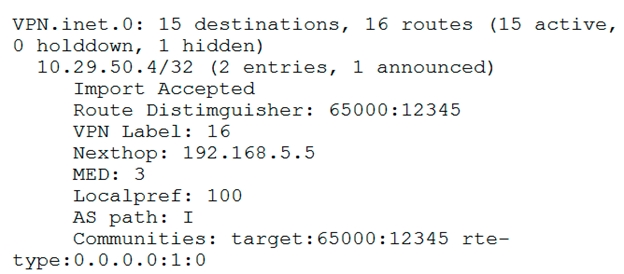
Why is the BGP session failing to establish?
- A. The vrf-table-label value is not configured in the remote PE.
- B. The route-distinguisher value on the local PE is incorrect.
- C. There is no route for 192.168.5.5 in inet.3.
- D. There is no route for 192.168.5.5 in VPN.inet.0.
Answer : A
Question 14
You are building a new IP fabric data center underlay network and want to ensure predictable load-balancing behavior for traffic traversing the fabric.
What are two approaches you should take to satisfy the requirement in this scenario? (Choose two.)
- A. Ensure that all uplinks are 40GbE.
- B. Ensure that every leaf node has a link to every other leaf node.
- C. Ensure that every leaf node has an uplink to every spine node.
- D. Ensure that all spine devices are the same switch model.
Answer : CD
Question 15
You are asked to enable plug-and-play for future line card switches in an active VCF without making any future Junos configuration changes. You are also required to ensure that all new line cards are automatically upgraded to the correct Junos version without any manual intervention.
In this scenario, which two actions will accomplish this task? (Choose two.)
- A. Ensure that the newly inserted line card's MAC addresses are present in the DHCP configuration for ZTP.
- B. Configure the auto-sw-update parameter on the VCF before inserting new line cards.
- C. Set the Virtual Chassis as pre-provisioned before the line cards are inserted.
- D. Set the Virtual Chassis as auto-provisioned before the line cards are inserted.
Answer : BD